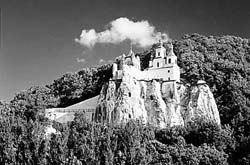Holy Mountain Singing Assembly

The temples on the premises of the Sviatohirsk [Holy Mountain] Monastery (Slovyanohorsk, Donetsk oblast) will host the Second All-Ukrainian Holy Mountain Vocal Festival on September 11-13, and the Solovyanenko Opera and Ballet Theater of Dnipropetrovsk will accommodate it Spt. 14.
Popularly known as the Holy Mountain Singing Assembly, it attracted considerable public interest in 2002, not only due to its well-selected concert program and high professional level, but also to its unique environs in a nature preserve. Last year, the festival involved six choirs with programs of Orthodox music dating from various periods, ranging from Byzantine to Georgian to Russian vocal pieces, including excellent works of the Ukrainian baroque period (Artem Vedel, Dmytro Bortniansky) and Ukrainian and Russian classics writing music for Orthodox rites (Mykola Lysenko, Modest Mussorgsky, and Peter Tchaikovsky) and modern composers (V. Tymozhynsky, M. Shukh, V. Stepurko).
This year’s festival will feature at its leading attraction the Khreshchatyk Municipal Choir directed by Larysa Bukhonska (Kyiv), winner of numerous prestigious awards. Among other participants will be the Revutsky Academic Men’s Choir of Ukraine (directed by People’s Artiste of Ukraine Bohdan Antkiv), Ukraine’s oldest such group (the only other one matching it in the Soviet Union was Estonia’s Choir directed by Gustav Ernesaks). Its vocal skill is admired all over the world. Its chamber group known under the Old Slavic name of Boyan, toured England and devotees would follow it, traveling from one city to the next. On learning about the Singing Assembly, a groups of Britishers asked the organizing committee to arrange for them to visit the town of Slovyanohirsk.
The Stritennia [Candlemas] Choir, specializing in Church Slavonic compositions, will also take part. This small performing group has a unique repertoire. Its artistic director, Ihor Sakhno, has been collecting and deciphering old church scores kept in the Byzantine, Georgian, and Kyiv Rus’ traditions. In fact, Stritennia is the festival’s discovery and their concert in the square facing St. Andrew’s Chapel last year was a major event last year.
The Holy Mountain Singing Assembly 2003 will further boast the men’s choir of the Kyiv Theological Academy and Seminary as one of the leading performers of the Kyiv- Pechersk Lavra Monastery of the Caves; the women’s choir of Kyiv’s Gliere College of Music, and the choir of the Prokofiev Conservatory of Music (Donetsk).
There will be a new project, the Spivoche Pole Singing Field, an open-air colorful dramatized event on the banks of the Siversky Donets River, starring contestants and guest choirs.
The 2003 assembly is also a workshop seminar. Professor Andre de Quadros, member of the board of the World Choral Music Association and Dean of the Music Department at Boston University, will conduct master classes with the Khreshchatyk Choir; Jerzy Stakewicz, music critic and Chairman of the Association of Polish Composers, will read a public lecture titled “Polish Choral Culture.”
HISTORICAL REFERENCE
The Sviatohirsk Monastery is a series of ground structures dating from a relatively late period, along with ancient caves dug in limestone hills formed some 80-150 million years ago. There are countless legends and assumptions relating to the caves, yet none has been substantiated. Perhaps the charismatic environs will eventually bring forth a sensational version of the very origin of the Holy Mountains. In fact, the locality was known under this name even before the first monks appeared. There are several allegations concerning the monastery’s origin. Most researchers believe it dates from the mid-thirteenth century, when Pechersk Lavra monks went there, after Batu Khan devastated Kyiv Rus’ and set up a cloistered community there. Several scholars insist that a Christian monastery emerged there in conjunction with the Horde’s onslaught. The third hypothesis is attributed to an archimandrite of the monastery who claimed that a group of monks from Mt. Athos had settled there in the fifteenth century. Other allegations date the monastery to the times of the Khazars and Polovtsians. Be it as it may, the Holy Mountain Monastery (subordinated to the Moscow Patriarchate of the Ukrainian Orthodox Church) currently ranks with the most important religious venues in Donetsk oblast, and as a site of pilgrimage. Located by the Siversky Donets, it reminds one of the Kyiv-Pechersk Lavra. And it is also a popular Ukrainian resort. The historical architectural preserve includes a sanitarium dating back 200 years, frequented by noted personalities at different periods, among them Anton Chekhov and Alexander Kuprin.






